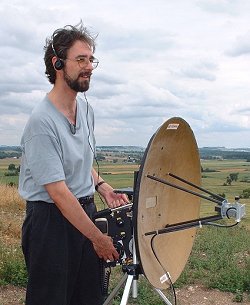 |
|
|

 |
An
Introduction to
|
1. INTRODUCTION
These pages are intended to offer the beginner to 10 GHz operation a general introduction to current practice in Ontario. It is not meant to provide complete technical details on how to build equipment, but rather to show what approaches are in common use and how the equipment is operated.
The 10 GHz band (10.0-10.5 GHz or 10000-10500 MHz) is one of the easiest microwave bands to get on, primarily as a result of its proximity to frequencies heavily used by various types of radars and the resulting equipment availability.
2. WIDEBAND FM
The most popular mode of operation on the amateur 10 GHz band in Ontario at present is wideband FM voice. By wideband, I mean the same bandwidth, more or less, as used by commercial FM broadcast stations. Typically this means about 75 kHz deviation and a receiver IF bandwidth of about 200-300 kHz. In practice this varies somewhat, depending on what equipment an individual amateur is using, but this is about the centre of the range.
This is a departure from the usual amateur practice on lower frequencies, where SSB and narrow band FM (about 5 kHz deviation) dominate for voice communication. These modes can be used at 10 GHz, but wideband FM allows the use of transmitters and receivers with relatively poor frequency stability. This means that equipment can be bought or built at much lower cost than would be needed for the more usual narrow band modes.
What do we give up by using wideband FM and simple equipment ? There are basically two things: (1) the poor frequency stability of the equipment means we can not just switch on the rig and be ready to communicate on a precisely defined channel, as we do on 2m FM, for example, and (2) the signals for a given power, antennas and distance, are not as strong as if we used a narrow band mode. However, the range can be surprisingly good at very low power levels.
Wide band FM activity in Ontario takes place mostly in the 10.200 - 10.400 GHz range.